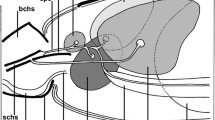Summary
Tick larvae were permitted to feed on infected hamsters and then allowed to molt. Nymphs were examined just prior to feeding on uninfected hamsters or at timed intervals thereafter. Invasion of the salivary gland by B. microti occurs before feeding of the nymph begins, and development of the parasite is further stimulated by feeding. The sporoblast forms a massive multinucleated meshwork which ramifies throughout the large host cell. No separation of the meshwork into multiple subdivisions, termed “cytomeres” by other workers, has been detected. Instead the specialized organelles characteristic of sporozoites, namely micronemes, rhoptries, and segments of double membrane appear in the meshwork itself and gradually become organized into sporozoite anlagen which protrude from its surface. At the same time the meshwork shortens and thickens giving rise to large compact undifferentiated bodies whose surface is also studded with sporozoite anlagen. Sporozoites thus originate either from the meshwork or from the undifferentiated bodies. In either case large lobate nuclei send projections into the anlagen as they protrude from the surface of the sporoblast. In a final step the mature sporozoites arise by simultaneous nuclear and cytoplasmic divisions. There is no separate stage of schizogony and the process is one of true budding.
Similar content being viewed by others
References
Fawcett DW, Doxsey S, Büscher G (1981a) Salivary gland of the tick vector (R. appendiculatus) of East Coast fever. I. Ultrastructure of the type III acinus. Tissue and Cell 13:209–230
Fawcett DW, Doxsey S, Büscher G (1981b) Salivary gland of the tick vector (R. appendiculatus) of East Coast fever. II. Cellular basis for fluid secretion in the type III acinus. Tissue and Cell 13:231–253
Fawcett DW, Büscher G, Doxsey S (1982a) Salivary gland of the tick vector of East Coast fever. III. The ultrastructure of sporogeny in Theileriaparva. Tissue and Cell 14:183–206
Fawcett DW, Büscher G, Doxsey S (1982b) Salivary gland of the tick vector of East Coast fever. IV. Cell type selectivity and host cell responses to Theileria parva. Tissue and Cell 14:397–414
Friedhoff K, Scholtyseck E, Weber G (1972) Die Feinstruktur der differenzierten Merozoiten von Babesia ovis. Z Parasitenkd 38:132–140
Karakashian SJ, Rudzinska MA, Spielman A, Lewengrub SJ, Shoukrey N, Piesman J (1982) Early developmental stages of Babesia microti in salivary glands of the tick. J Protozool 29:498
Kilejian A (1976) Does a histidine-rich protein from Plasmodium lophurae have a function in merozoite penetration? J Protozool 23:272–281
Mehlhorn H, Schein E, Warnecke M (1979) Electron microscopic studies on Theileria ovis Rodhain, 1916. Development of kinetes in the gut of the vector tick Rhipicephalus evertsi evertsi Neumann, 1897, and their transformation within cells of the salivary glands. J Protozool 26:377–385
Moltmann UG, Mehlhorn H, Friedhoff KT (1982a) Electron microscopic study on the development of Babesia ovis (Piroplasmia) in the salivary glands of the vector tick Rhipicephalus bursa. Acta Trop 39:29–40
Moltmann UG, Mehlhorn H, Friedhoff KT (1982b) Ultrastructural study of the development of Babesia ovis (Piroplasmia) in the ovary of the vector tick Rhipicephalus bursa. J Protozool 29:30–38
Piesman J, Spielman A (1982) Babesia microti: Infectivity of parasites from ticks for hamsters and white-footed mice. Exp Parasitol 53:242–248
Piesman J, Rudzinska MA, Spielman A, Lewengrub S (1981) “Sporozoites” of Babesia microti in the tick vector Ixodes dammini. Prog Protozool, VI Int Congr Protozool: 298
Rudzinska MA (1976) Ultrastructure of intraerythrocytic Babesia microti with emphasis on the feeding mechanism. J Protozool 23:224–233
Rudzinska MA (1981) Morphologic aspects of host-cell-parasite relationships in babesiosis. In: Ristic M, Kreier JP (eds) Babesiosis. Academic Press, New York London Toronto Sydney San Francisco, pp 87–141
Rudzinska MA, Spielman A, Riek RF, Lewengrub SJ, Piesman J (1979) Intraerythrocytic “gametocytes” of Babesia microti and their maturation in ticks. Can J Zool 57:424–434
Rudzinska MA, Spielman A, Lewengrub S, Piesman J, Karakashian S (1982) Penetration of the peritrophic membrane of the tick by Babesia microti. Cell Tissue Res 221:471–481
Rudzinska MA, Lewengrub S, Spielman A, Piesman J (1983) Invasion of Babesia microti into epithelial cells of the tick gut. J Protozool: in press
Ruebush II TK, Juranek DD, Spielman A, Piesman J, Healy GR (1981) Epidemiology of human babesiosis on Nantucket Island. Am J Trop Med Hyg 30:937–941
Schein E, Mehlhorn H, Voight WP (1979) Electron microscopical studies on the development of Babesia canis (Sporozoa) in the salivary glands of the vector tick Dermacentor reticulatus. Acta Trop 36:229–241
Spielman A, Clifford CM, Piesman J, Corwin MD (1979) Human babesiosis on Nantucket Island, USA. Description of the vector, Ixodes (Ixodes) dammini, n. sp. (Acarina: Ixodidae). J Med Entomol 15:218–234
Spielman A, Etkind P, Piesman J, Ruebush II TK, Juranek DD, Jacobs MS (1981) Reservoir hosts of human babesiosis on Nantucket Island. Am J Trop Med Hyg 30:560–565
Walter G, Weber G (1981) Untersuchung zur Übertragung (transstadial, transovarial) von Babesia microti, Stamm Hannover I, in Ixodes ricinus. Tropenmed Parasitol 32:228–230
Weber G, Walter G (1980) Babesia microti (Apicomplexa: Piroplasmida). Electron microscopic detection in salivary glands of the tick vector Ixodes ricinus (Ixodoidea: Ixodidae). Z Parasitenkd 64:113–115
Author information
Authors and Affiliations
Additional information
Supported by Research Grant AI-15886 from the United States Public Health Service
The expert technical assistance of Ms. Ellen Lanners is gratefully acknowledged
Rights and permissions
About this article
Cite this article
Karakashian, S.J., Rudzinska, M.A., Spielman, A. et al. Ultrastructural studies on sporogony of Babesia microti in salivary gland cells of the tick Ixodes dammini . Cell Tissue Res. 231, 275–287 (1983). https://doi.org/10.1007/BF00222180
Accepted:
Issue Date:
DOI: https://doi.org/10.1007/BF00222180




